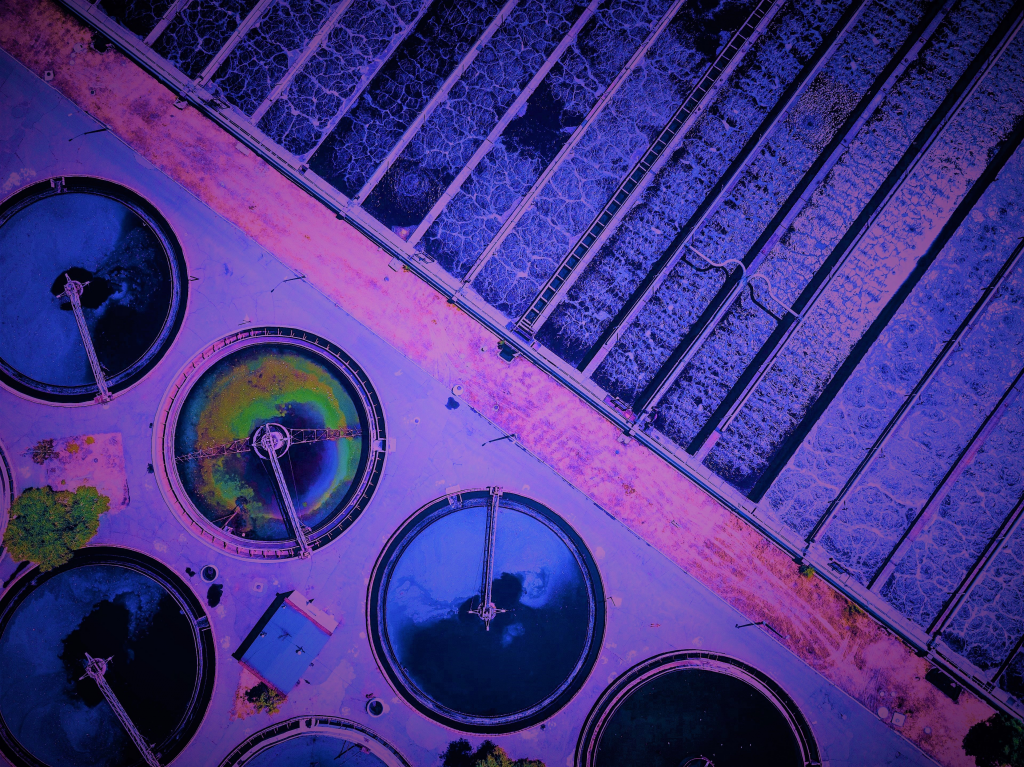The level of hard work and dedication behind the clean water we receive from our taps, as well as the waste water that is strenuously treated, can sometimes be taken for granted – intense and highly planned work that gives us the ability to live in good health and with a piece of mind. Extensive safety procedures, engineering work, scientific breakthroughs and technological applications amongst many other important aspects are undertaken to keep the water clean and safe around the world. The water industry is important, but also very exciting – and without it our basic human needs are not met.

Figure 1: Photo by Ivan Bandura on Unsplash.
It might be the case that you have seen some pictures of wastewater runoffs and dirty sewers and thought about how horrible it looks and indeed must smell. You may have even asked yourself how something so contaminated can be treated well enough to be reused, used for fertilizers or at all be broken down to safer compounds. This calls upon the question – how do the treatment plants with their associated technologies work and operate?

Figure 2: Photo by Daniel Sinoca on Unsplash.
Two Separate Treatment Processes
Initially, we can separate the treatment processes into two: water treatment with clean water from various raw water sources and wastewater treatment from sewage and contaminated water. Both serve the purpose of cleaning the water, but as a general difference the the output of wastewater plants are streams or rivers, and the output of drinking water plants are your city’s pipe networks and distribution systems [2]. As mentioned by Interesting Engineering, the treatments are essential processes that allow us to live our lives without having to think about our own waste.
Water treatment refers to the treatment of water from water sources, mainly fresh water, such as lakes, rivers, reservoirs all the way up to supply in our taps [1]. Such water is usually not too contaminated and containing certain dissolved substances. Thus, typical water treatment processes may involve physical treatment like filtering and addition of chemicals such as chlorine and fluorine or disinfection through UV, to give the water certain characteristics.

Figure 3: Photo by Johnny Brown on Unsplash.
Wastewater treatment rather refers to the purification of water that is contaminated to a degree which is unsafe [1]. The contamination itself may come from municipal sewage systems and industrial sources.
Such wastewater is typically quite badly contaminated with many of the contaminants being dissolved. As such, wastewater treatment is more extensive and would involve entirely different processes such as secondary or biological treatment systems (aerobic, anaerobic and anoxic) and perhaps also involve membrane systems or cloth filters.

Figure 4: Photo by Ivan Bandura on Unsplash.
Stages of Water Treatment Versus Wastewater Treatment
See the steps below to compare these in juxtaposition:
| Water Treatment | Wastewater Treatment | |
|---|---|---|
| 1 | Surface Water Source (including prior Entrance Building = Gate/Security) – Through the us of boreholes or by other means | Inlet Works Pre-Treatment and Screens (including prior Entrance Building = Gate/Security) – Heavy particles, RAG and fibre – May cause: Blockage or fouling machinery Removal method: Coarse and Fine screens (i.e. bar) – Lighter and finer particles, grit, silt (and possible clay) and sand May cause: Blockage and/or wear and tear Removal method: Sedimentation; including skim-off method, classifier |
| 2 | Purification or Clarification (pollution/contaminant reduction) Process – Coagulation – Destabilize and neutralize particles – Flocculation – Add or make floc for collision and transportation – Sedimentation (sedimentation in sedimentation tank) [2] | Primary Treatment – Clarifiers or Primary Settlement Tanks (PSTs) |
| 3 | Filtration (Filtering Out) – Solids removal | Secondary or Biological Treatment – Biological Filters: are houses to grow bacteria – Feeds oxygen and water to develop bacteria – Fixed Growth process: Circulated gravel filters that filter and oxygen enters slowly and evenly to grow bacteria – High-rate bio filters – congregated filters with high surface area for reaction to happen – Suspended growth process: The activated sludge process – diffuser with aeration (oxygen) – Secondary sedimentation / Filtration |
| 4 | Disinfection – UV – Chlorination – Ozone | Optional Tertiary Treatment – Cloth Filter – Membrane bio reactors (have to be backwashed resulting in contaminated water to waste) |
| 5 | Optional Storage – In case of purification problems, safety containment. | Optional Sludge Treatment – Centrifuge, belt presses, conveyor belts etc. |
| 6 | Water supply and distribution | Sludge Dewatering and Solids Collection |
| 7 | N/A | Sludge Recycle or Storage |
| 8 | N/A | Recycle, Storage or Transport to Waste Management or Water Source – Recycle the wastewater – Storage in case of purification problems, safety containment. – Transport the solids or sludge to waste management – Discharge wastewater following treatment to water source such as river, lake or sea |
Summary of Water Treatment Process
As shown in the table above and in the figure below about water treatment, potable or drinking water will start off at the water source, which is generally a freshwater lake, well, river or stream. Below a focus has been given on surface water sources as opposed to groundwater sources, due to the reduced need for extensive treatment and of solids removal for this type of supply. The first step of treatment is to remove the settleable and dissolved solids suspended in the water using a process called clarification, which is as it sounds – clarifying the water.

Figure 5: Simplified illustration showing some of the steps for water treatment.
In order to hurry the clarification and removal process, chemicals called coagulants are added to the water. These will destabilize the molecules in the wastewater. This will during flocculation be stabilized again as well as transporting these, allowing certain molecules to grow in size. The growth is then prolonged with sedimentation over time. This will help the filtering process which will follow next.
The filtration separates and filters out the so-called floc. As the larger molecules are separated, disinfection is then followed through ultraviolet (UV), ozone or chlorine disinfection. This will remove and kill the most severe bacteria.
Testing is to be carried throughout. A final monitoring and testing will be undertaken to confirm that this is indeed the case, and it is most critical at the taps. The reason is due to any leakages or harmful inclusion that might occur before our taps and any testing prior to this leakage might go unnoticed. The water is then transferred to water supply networks for use within our taps.
Summary of Wastewater Treatment Process
As shown in the table above and in the figure below about wastewater treatment, the steps of waste treatment will initially involve pre-treatment and screening of the combined inflow or so-called influent. The influent is sewage and depending on the country it may also include rainwater. As a common note within the wastewater treatment process, solids will be removed in almost all of the stages.

Figure 6: Simplified illustration showing some of the steps for wastewater treatment.
It is certainly a good starting point for the initial necessary screens as the solids could block or cause other issues. These are called coarse screens, commonly known as bar screens, to remove large solids and objects within the wastewater treatment. The wastewater then pass through fine screens to remove finer particles.
Once the screening is carried out, primary settlement tanks (clarifiers) will make sue that the primary sludge settle out in the bottom while the lighter settled wastewater will pass through to secondary or biological treatment. At this point, optional tertiary treatment in the form of membrane or filters can be implemented or be directed through recycle or storage to waste management or water source. The latter may involve a final outfall point before a river or a lake if the wastewater is safe for effluent (treated) discharge.
As another set of steps before the final outfall, sludge treatment may be included within the treatment if needed. To manage the sludge, machinery be operated which then press, filter or affects the sludge content through centrifugal operation. At the same time as the process media of filtrate or centrate flows out, a dewatering process is also carried out. – Solids and heavy sludge is collected, where the solids are often collected in the form of a skip or container, whilst the filtrate or centrate flows through to recycle or storage.
In addition to the treatments themselves, a high amount of strenuous effort and hard work is put into the mud and grit to get all the pipes, plant items and machinery working as they should. The water industry is truly amazing and keeps us in a blissful paradise and peace without ever having to worry about what happens before getting our clean water or after disposing of our waste.
As seen, the treatments are essential processes that allow us to live our lives without having to think about our own waste. Essentially, they keep us free of daily concern and now after seeing the hard work put behind these treatments and stages, we can surely say that we owe them our thanks.
Special thanks to:
My fellow colleagues and previous team-mates at Trant Engineering Ltd. Trant is an innovative company and I have been lucky to be a part of this company – getting highly valuable engineering experience from projects carried out in the water industry. This has also been a massive help in creation of this article.
References
[1] Quora. 2017. Available [Online]: https://www.quora.com/Whats-the-difference-between-water-and-waste-water-treatment-hydrology-and-water-resources-and-water-resources-management
[2] Interesting Engineering. 2021. Available [Online]: https://interestingengineering.com/dirty-clean-how-water-treatment-plant-works
[3] Interesting Engineering. 2021. Available [Online]: https://interestingengineering.com/how-modern-wastewater-treatment-changed-our-world


